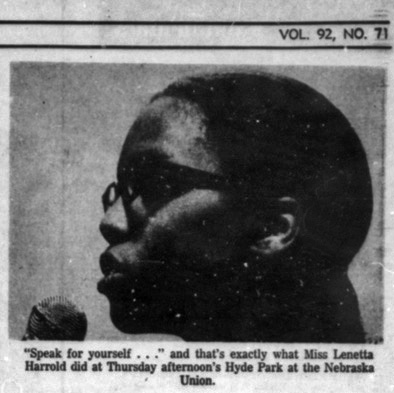Projects
"Citadel of Apathy"?: Student Activism at UNL, September 1968-May 1969Project Editor: Jillian Gotfredson, History 470: Digital History, Spring 2008 Active or Apathetic?
Hyde Park Forum
|
The original American Hyde Park was in Chicago, Illinois' Bughouse Park a.k.a. Washington Square Park. It was the "most celebrated outdoor free-speech center in the nation" and the tradition of "soapboxers" went back to 1910 .
Located on the corner of Park Lane and Cumberland Gate in London's Hyde Park, the Speaker's
Corner is "the spiritual home of the British democratic tradition of soapbox oratory" and dates back to 1872 . Every Sunday, people exercise their right to the freedom of speech. Hyde Park's Speaker's Corner is also known as a popular site for protests.
In 1965-1966, Carl Davidson and Students for a Democratic Society created the Hyde Park Forum at the University of Nebraska as a way to debate and open the lines of communication on issues concerning students. Originally, the forum took place every Thursday in front of the Union, it was an open mike and anyone could get up say whatever they wanted for four minutes. Attendance at the University of Nebraska's Forum ranged from the hundreds to the tens and in early 1968 some speculated Hyde Park would die. However, the Forum was revived before the 1968-1969 school year and remained a place for a public discourse community.
Topics

| Lenetta Harrold speaks at the Hyde Park Forum, c. 1969 |
Much like Chicago and London, the debates or discussions at the Hyde Park Forum centered on a broad spectrum of issues concerning international, national, and local happenings. From a grape boycott, to racism, to religion, to Vietnam, to women's hours in Campus dorms, the topics varied each week. Speeches were unscripted and were often just comprised of someone talking just to talk. Below are two examples of what went on at the Forum.
A September Forum focused on the abolishment of women's hours in the dorms arguing that it is not the University's place to say when they can come and go. The Forum took place in the Nebraska Union Lounge in front of about 100 people. A University policeman sat in the back and a silent and small protest took place as some chose to go barefoot (earlier a barefoot student was stopped and told to leave the building) .
In an October Forum, students rapped about ROTC as a credit course, supporting Biafra, president Craig Dreezen talked about Time Out (student concern programs), and an administrator commended activists on the but said it was now the time for individuals to do something, to reach out to others and make a personal and individual contribution .
| 
